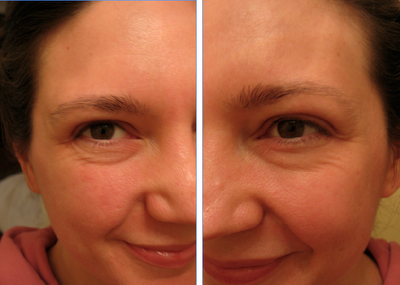You see the problem here is simply trying to figure out what these conditions, or syndromes, or diseases, or whatever, are even called, much less what they actually are. No wonder around 60% of us consider themselves to have “sensitive skin”—who hasn’t at some point gotten a little itchy from something? So part of the sensitive skin conundrum is that the meaning of the term is largely subjective. A dermatologist might be able to look at your red, rashy skin and say that it looks like a reaction to a cosmetic, but when it comes to other symptoms of sensitive skin, you’re the only one calling the shots. There’s no medical threshold you need to cross to proclaim that your skin feels “tingly” or “tight.”
Skin—unlike, say, the spleen—is an organ generally thought of in terms of appearance, not health, at least if you’re judging where consumer dollars are spent. Its unique place on the health-beauty spectrum means that we imbue skin with all sorts of judgments—some of which might be accurate, some of which might not be. For example, I used products meant for “oily skin” for years because my face is always shiny, but in truth I have utterly normal skin—I was just self-conscious about my shine, and by using products meant for a skin type I didn’t have, I was actually hurting my skin, not helping it.
Sensitive skin’s openness to interpretation makes it a prime candidate for marketingspeak. Like most cosmetics claims, there’s no legal or industry standard for what products can claim to be “safe for sensitive skin.” Which is not to say that products marketed toward people with sensitive skin are bogus—like “hypoallergenic” products (another term with no industry standard), these products usually have no dyes or perfumes, and active ingredients may have been tweaked to be more mild. But there is something...odd? fishy? about a market full of people who have been largely self-diagnosed turning to the beauty industry for what amounts to self-treatment—especially in cases where it’s a beauty product that provokes a skin reaction in the first place.
Which leads to the big question here: Why do so many of us believe we have sensitive skin? Natural beauty advocates would posit that the cosmetics industry, being basically unregulated, uses all sorts of chemicals that have no place on our bodies. Certainly there’s a big argument to be made here about skin sensitivities, natural products, health, and the environment. But it’s not like sensitive skin products are solely in the realm of the natural-foods store: Having a “sensitive skin” market benefits the mainstream beauty industry. I remember reading a bit in Paco Underhill’s Why We Buy: The Science of Shopping about how if a consumer believes that a product has been specifically recommended for her, she’s more likely to buy it. Logically, then, if a consumer puts herself into a market of people with special needs, she’s more likely to buy products recommended for people in her particular niche.
Still, sensitive skin isn’t actually a niche: More people believe they have it than believe they don’t, with up to 60% of us reporting sensitive skin. But the term sensitive implies something different, a little special, a little unique—and who doesn’t want to believe there’s something unique about us (even if we’re actually in the majority)? And if it’s something that has a nice ring about it—something that allows us our human frailty but under the guise of having a medical-ish condition, one that’s not serious but that needs some tender care regardless—all the better. Much of the time women are told not to be so sensitive. If there’s an umbrella that allows us to be as sensitive as we damn well please, why wouldn’t we take it?
But! Men are included in that 60% figure. In fact, according to recent research from Procter & Gamble, 70% of men believe they have sensitive skin. Now, obviously P&G has a stake in finding and reporting a submarket among their existing Gillette consumers, so I’m not going to put tons of stock in that number. But the sudden appearance of all these sensitive-skinned men correlates time-wise to the overall rise in skin-care products for men. (In fact, it may be that that makes men realize they have sensitive skin—since many forms of the condition only result in a sensitivity toward products, women have a higher chance of recognizing their sensitivities since they experiment with more products.) And I also can’t help but wonder how the word sensitive relates to men here—the beauty industry is hardly shy about painting men’s and women’s needs as being so different as to require different terminology. (Grooming vs. beauty, for example.) So I don’t think it’s a coincidence that the industry has kept the word sensitive in describing products for men. It might be tucked in among all sorts of hypermasculine terms—say, the Gillette Mach 3 Turbo Sensitive razor—but it’s there, not coded as allergy-prone or irritable or pissed-off (we’re talking about an industry that features products named things like Butt Taco, okay?), plain old sensitive, same as the ladies. By gently introducing into male-marked spaces terms generally applied to women, the beauty industry—excuse me, the grooming industry—subtly primes its market for other feminine markings. Sensitive men might not cry, but would they wear concealer? Perhaps.
I’m not trying to say that people with sensitive skin shouldn’t have a market directed toward them, or that we’re all making it up to feel like a special snowflake, or that we’re all just pawns of the beauty industry, or that we should be turning more to dermatologists. Obviously sensitive skin exists on a wide spectrum, and I don’t think you need to have weeping wounds before you start to investigate if niche products would be less problematic for your skin. Believing that your skin is sensitive is enough to make it sensitive—and what’s the harm in buying a product with fewer irritants? Maybe the beauty industry would be wise to flip it: Begin with a baseline allergen-free product, and build up to products meant for “hardy skin.” Think of the swagger that would come with announcing that you’ve started on Olay’s Level 4 Hardy Skin regime! Until then, though, we’re left with sensitivity as the exception, not the rule—even though it’s really the other way around.




















